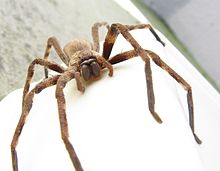Sparassidae
| Huntsman spider | |
|---|---|
 |
|
| Palystes castaneus, showing sparassid pattern of eyes in two rows of four, with the robust build and non- pedipalps of a female. | |
| Scientific classification | |
| Kingdom: | Animalia |
| Phylum: | Arthropoda |
| Subphylum: | Chelicerata |
| Class: | Arachnida |
| Order: | Araneae |
| Infraorder: | Araneomorphae |
| Family: |
Sparassidae Bertkau, 1872 |
| Diversity | |
| 82 genera, > 1,000 species | |
 |
|
Huntsman spiders, members of the family Sparassidae (formerly Heteropodidae), are known by this name because of their speed and mode of hunting. They also are called giant crab spiders because of their size and appearance. Larger species sometimes are referred to as wood spiders, because of their preference for woody places (forests, mine shafts, woodpiles, wooden shacks). In southern Africa the genus Palystes are known as rain spiders or lizard-eating spiders. Commonly they are confused with baboon spiders from the Mygalomorphae infraorder, which are not closely related.
More than a thousand Sparassidae species occur in most warm temperate to tropical regions of the world, including much of Australasia, Africa, Asia, the Mediterranean Basin, and the Americas.
Several species of huntsman spider can use an unusual form of locomotion. Carparachne aureoflava from the Namib desert uses a cartwheeling motion, while Cebrennus rechenbergi uses a flic-flac motion.
Sparassids are eight-eyed spiders. The eyes appear in two largely forward-facing rows of four on the anterior aspect of the prosoma. Many species grow very large – in Laos, Heteropoda maxima males attain a legspan of 250–300 mm (about 10–12 in). Persons unfamiliar with spider taxonomy commonly confuse large species with tarantulas, but huntsman spiders can generally be identified by their legs, which, rather than being jointed vertically relative to the body, are twisted in such a way that in some attitudes the legs extend forward in a crab-like fashion.
...
Wikipedia
